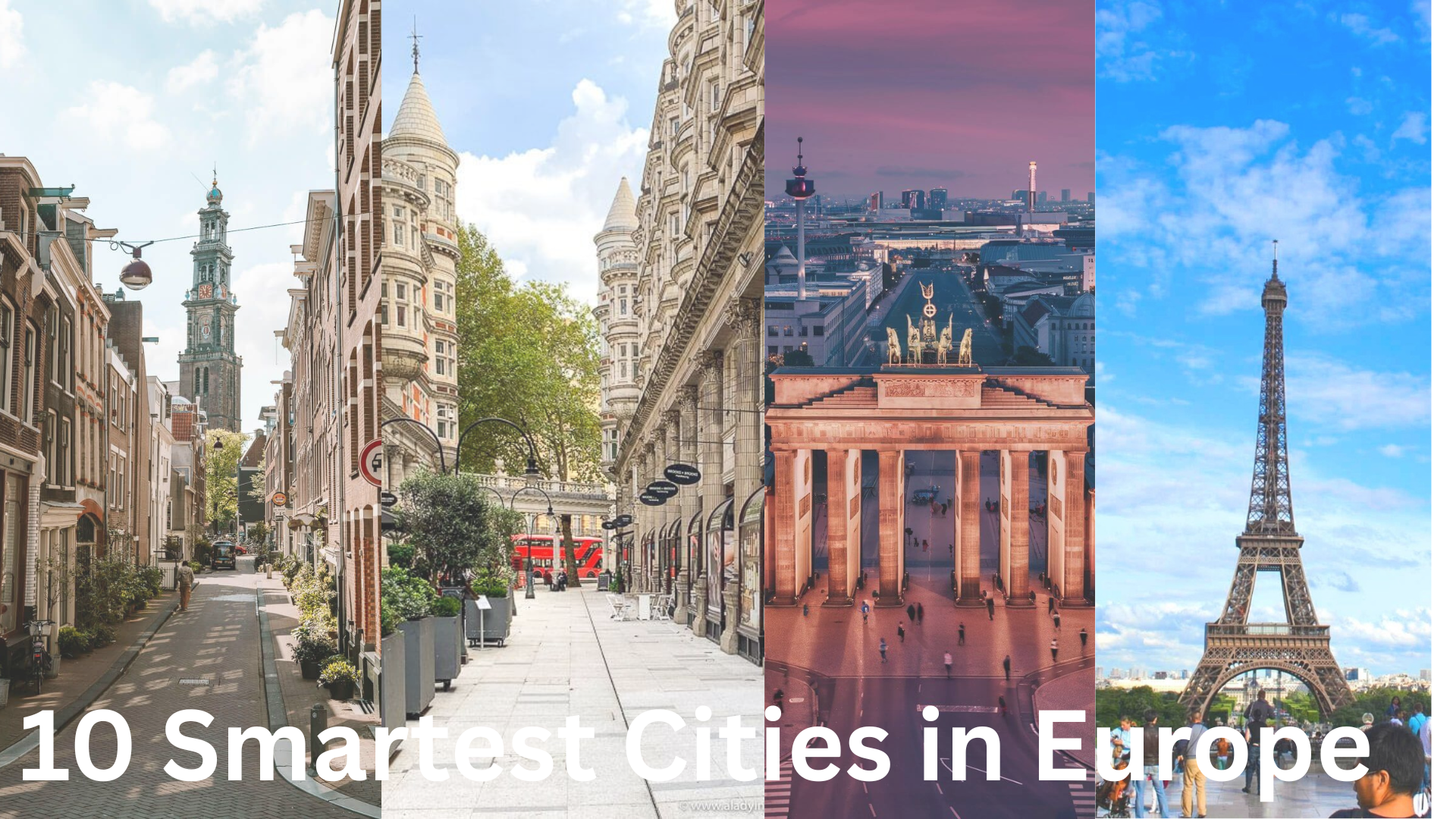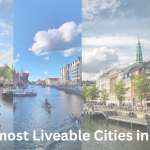Smart cities leverage technology, data, and innovation to enhance quality of life, sustainability, and efficiency. In 2025, Europe’s smartest cities—Paris, London, Amsterdam, Berlin, Madrid, Lisbon, Stockholm, Luxembourg, Dublin, and Copenhagen—stand out for their advancements in urban mobility, digital infrastructure, environmental policies, and citizen engagement. This article explores why these cities lead, highlighting their smart initiatives and what makes them vibrant hubs for residents and visitors.
1. Paris, France
Paris tops the list, blending cultural heritage with smart urban solutions. The city’s 15-minute city initiative ensures residents can access essentials within a short walk or bike ride, reducing car use. Paris’s smart mobility includes 10,000 Vélib’ bikes and 1,400 electric buses, with 5G coverage across 90% of the city. The Smart Paris program integrates IoT for waste management and energy-efficient buildings. Housing costs are high ($1,500-$2,500 for a one-bedroom), but free Wi-Fi in public spaces and cultural hubs like the Louvre make Paris a smart, livable capital.
2. London, United Kingdom
London, a global tech hub, ranks second with its Smart London Plan, emphasizing data-driven urban management. The city’s 5G networks and 9,000+ free Wi-Fi hotspots ensure connectivity. Congestion pricing and 20,000 electric vehicle charging points promote sustainability. London’s tech cluster in Shoreditch and innovation hubs like Imperial College drive digital advancements. One-bedroom rents average $2,000-$3,000, but efficient public transport (Oyster card: $10/day) and smart apps like Citymapper ease navigation. Cultural landmarks like the British Museum add to its appeal.
3. Amsterdam, Netherlands
Amsterdam excels in smart mobility and sustainability, with 400 km of bike lanes and 70% of residents cycling daily. The Amsterdam Smart City initiative uses IoT for traffic management and smart lighting, reducing energy use by 30%. The city’s 5G network and coworking spaces like WeWork attract digital nomads. Housing costs ($1,500-$2,200 for a one-bedroom) are high, but free canal-side Wi-Fi and green spaces like Vondelpark enhance livability. Amsterdam’s circular economy goals, aiming for 50% waste reduction by 2030, solidify its smart status.
4. Berlin, Germany
Berlin’s smart city strategy focuses on open data and inclusivity. The Smart City Berlin 2030 plan integrates AI for traffic flow and renewable energy, with 40% of electricity from solar and wind. Affordable rents ($1,000-$1,800 for a one-bedroom) and a vibrant startup scene (3,000+ startups) draw innovators. Free Wi-Fi in 650 public spots and efficient U-Bahn transit ($3/ride) support connectivity. Berlin’s cultural diversity, from Museum Island to techno clubs like Berghain, pairs with smart governance to create a dynamic urban hub.
5. Madrid, Spain
Madrid’s smart city initiatives emphasize sustainability and citizen engagement. The Madrid 360 plan aims for carbon neutrality by 2050, with 1,000 electric buses and 10,000 bike-sharing stations. IoT-enabled waste bins and smart parking reduce congestion. One-bedroom rents average $900-$1,500, making Madrid more affordable than peers. Free Wi-Fi in plazas and cultural attractions like the Prado Museum enhance appeal. The city’s 5G rollout and tech hubs like South Summit make it a growing innovation center.
6. Lisbon, Portugal
Lisbon, a rising star, blends affordability with smart solutions. The Lisboa Inteligente platform uses data analytics for urban planning, optimizing traffic and energy use. The city’s 5G network and 200+ coworking spaces cater to digital nomads. One-bedroom rents ($800-$1,400) are budget-friendly, and electric trams ($2/ride) ensure mobility. Lisbon’s sunny climate, Alfama district, and startup ecosystem (e.g., Unicorn Factory) make it attractive. Smart waste systems and 50% renewable energy use by 2030 highlight its green commitment.
7. Stockholm, Sweden
Stockholm leads in sustainability, aiming for fossil-fuel-free status by 2040. The Smart City Stockholm initiative uses IoT for energy-efficient buildings and waste management, recycling 70% of waste. The city’s 5G coverage and free Wi-Fi in public squares support connectivity. One-bedroom rents ($1,200-$2,000) are high, but efficient metro systems ($4/ride) and green spaces like Djurgården balance costs. Stockholm’s tech scene, home to Spotify, and cultural venues like the Vasa Museum make it a smart, livable city.
8. Luxembourg, Luxembourg
Luxembourg, a financial powerhouse, excels in smart governance and connectivity. The city’s Digital Luxembourg strategy offers 5G across 95% of the area and free Wi-Fi nationwide. Smart mobility includes free public transport for all residents, a global first. One-bedroom rents ($1,500-$2,500) reflect high wages, but low crime and green initiatives, like 30% forest coverage, enhance livability. Cultural sites like the Bock Casemates and a multilingual population make Luxembourg a compact, smart hub.
9. Dublin, Ireland
Dublin’s smart city efforts focus on tech and citizen services. The Smart Dublin initiative uses sensors for flood monitoring and traffic management, with 5G in 80% of the city. Tech giants like Google and Meta drive innovation, though one-bedroom rents ($1,800-$2,500) are steep. Affordable public transport ($3/ride) and free Wi-Fi in Temple Bar ease costs. Dublin’s vibrant culture, from Guinness Storehouse to Trinity College, and startup-friendly policies make it a dynamic smart city, despite housing challenges.
10. Copenhagen, Denmark
Copenhagen, a leader in sustainability, aims for carbon neutrality by 2025. The CPH City & Port Development uses AI for energy and waste management, recycling 60% of waste. The city’s 400 km of bike lanes and 5G network support mobility and connectivity. One-bedroom rents ($1,200-$2,000) are high, but efficient trains ($4/ride) and green spaces like Tivoli Gardens enhance livability. Copenhagen’s tech hub and cultural sites, like Nyhavn, make it a model smart city.
Why These Cities Are Smart
These cities excel due to advanced technology, sustainability, and citizen-focused governance. Paris and Copenhagen lead in green mobility, with bike-sharing and electric buses, while London and Amsterdam leverage 5G and IoT for urban efficiency. Berlin and Lisbon offer affordability, attracting startups, while Stockholm and Luxembourg prioritize renewable energy and connectivity. Madrid and Dublin balance cultural heritage with innovation, creating livable, forward-thinking urban spaces. High scores in the IESE Cities in Motion Index (e.g., London, Paris) reflect their global leadership.
Key Features of Smart Cities
- Technology: 5G networks (Amsterdam, Luxembourg) and IoT (Stockholm, Madrid) optimize services.
- Sustainability: Copenhagen’s carbon-neutral goal and Lisbon’s renewable energy push reduce environmental impact.
- Mobility: Paris’s 15-minute city and Copenhagen’s bike lanes cut congestion.
- Affordability: Berlin and Lisbon offer lower rents, balancing high-cost peers like London.
Challenges like housing costs (Dublin, Zurich) and data privacy concerns persist, but these cities mitigate through transparency and investment.
Tips for Living or Visiting
- Housing: Seek suburbs (e.g., Amadora for Lisbon, Kreuzberg for Berlin) to cut rent costs.
- Transport: Use bike-sharing in Amsterdam or Copenhagen ($1-$2/ride) and public transit apps.
- Connectivity: Leverage free Wi-Fi in Paris, Luxembourg, or Berlin’s public spaces.
- Plan Visits: Spring (April-May) or fall (September-October) offer mild weather and fewer crowds.
- Engage Locally: Join coworking spaces (WeWork in London, Lift99 in Lisbon) for networking.
Conclusion
Europe’s smartest cities in 2025—Paris, London, Amsterdam, and beyond—blend cutting-edge technology with sustainable, citizen-centric solutions. From Copenhagen’s green ambitions to Berlin’s startup vibe, each offers unique strengths. While high costs challenge some, their innovation, connectivity, and cultural richness make them global leaders, worth exploring with smart planning.














